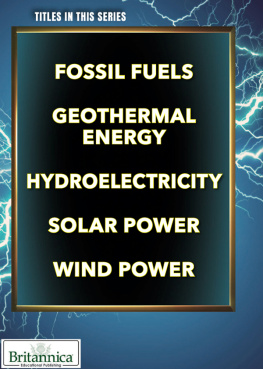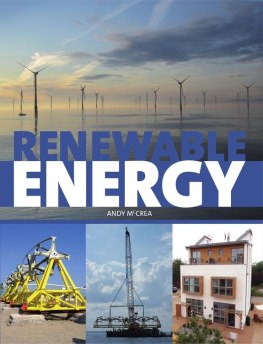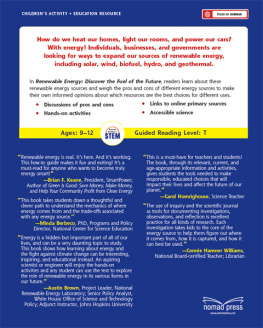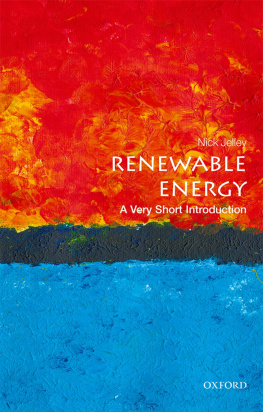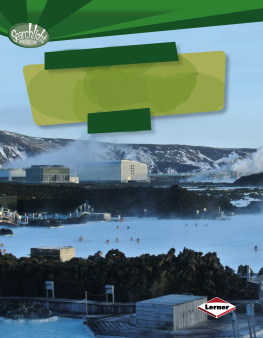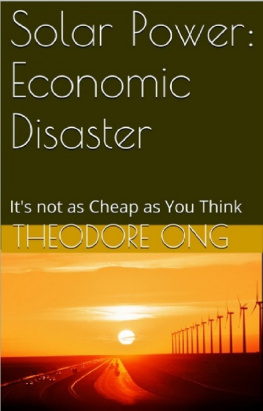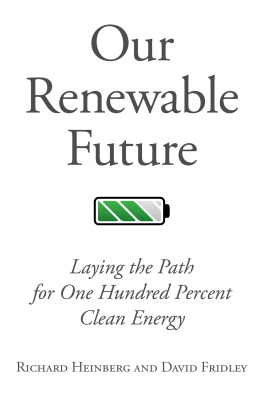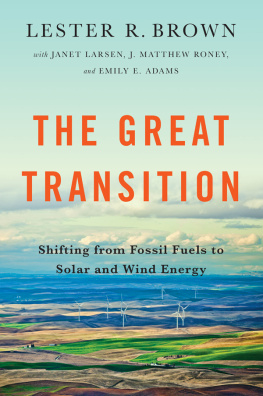Published in 2019 by Britannica Educational Publishing (a trademark of Encyclopdia Britannica, Inc.) in association with The Rosen Publishing Group, Inc.
29 East 21st Street, New York, NY 10010.
Copyright 2019 by Encyclopdia Britannica, Inc. Britannica, Encyclopdia Britannica, and the Thistle logo are registered trademarks of Encyclopdia Britannica, Inc. All rights reserved.
Rosen Publishing materials copyright 2019 The Rosen Publishing Group, Inc. All rights reserved.
Distributed exclusively by Rosen Publishing.
To see additional Britannica Educational Publishing titles, go to rosenpublishing.com.
First Edition
Britannica Educational Publishing
J.E. Luebering: Executive Director, Core Editoria
Andrea R. Field: Managing Editor, Comptons by Britannica
Rosen Publishing
Amelie von Zumbusch: Editor
Brian Garvey: Series Designer/Book Layout
Cindy Reiman: Photography Manager
Nicole DiMella: Photo Researcher
Library of Congress Cataloging-in-Publication Data
Names: Lachner, Elizabeth, editor.
Title: Geothermal energy / edited by Elizabeth Lachner.
Description: New York : Britannica Educational Publishing, in Association with Rosen Educational Services, 2019 | Series: Exploring energy technology | Audience: Grades 58. | Includes bibliographical references and index.
Identifiers: LCCN 2018014133| ISBN 9781508106173 (ebook)
Subjects: LCSH: Geothermal resourcesJuvenile literature. | Geothermal power plantsJuvenile literature.
Classification: LCC GB1199.5 .G45275 2018 | DDC 333.8/8dc23
LC record available at https://lccn.loc.gov/2018014133
Manufactured in the United States of America
Photo credits: Cover 4FR/E+/Getty Images; cover, back cover and interior pages (background) iStockphoto.com/tolokonov; pp. 4-5 Gretar varsson; pp. 6, 9, 11, 12, 16, 21, 24, 25 Encyclopdia Britannica, Inc.; p. 15 Stockbyte/Thinkstock; p. 19 Mirek Nowaczyk/Shutterstock.com; p. 28 Robert Hoetink/Shutterstock.com; p. 30 Boyloso/Shutterstock.com; p. 32 Pi-Lens/Shutterstock.com; p. 35 MakDill/Shutterstock.com; p. 38 AP Images; p. 39 Alexander Piragis/Shutterstock.com; p. 40 Bloomberg/Getty Images.

G eothermal energy is heat that comes from inside Earth. It can be used for cooking, bathing, and heating. It can also be converted into electricity. Geothermal energy from natural pools and hot springs has been used throughout history, including by Native Americans and the ancient Greeks and Romans.

This is the Nesjavellir Geothermal Power Plant, in Iceland. It is used to generate electricity and to supply hot water, which is used both for bathing and for heating.
Geothermal energy is available anywhere on Earths surface. In some places, such as Iceland, the heat is so close to the surface it can be easily used as an energy source. In Iceland, most homes are heated by hot water tapped from volcanic springs. Greenhouses heated in the same way provide fresh vegetables and fruits to this subarctic island. In other places holes must be drilled down through rocks to reach the heat.
The amount of usable energy from geothermal sources varies considerably. Geothermal energy is best found in areas with high thermal gradients. Those gradients occur in regions affected by recent volcanic activity, in areas located along plate boundaries (such as along the Pacific Ring of Fire), or in areas marked by thin crust (hot spots) such as Yellowstone National Park and the Hawaiian Islands. Areas near volcanic activity often have features that bring heat from deep inside Earth right to the surface, such as lava flows, geysers, or hot springs. In other places, the extraction of geothermal energy can be more challenging. For successful extraction, geothermal reservoirs must have adequate permeability or faults that allow fluids to rise close to the surface and an impermeable caprock to prevent the escape of heat. In addition, such reservoirs must be economically accessible (that is, within the range of drills).
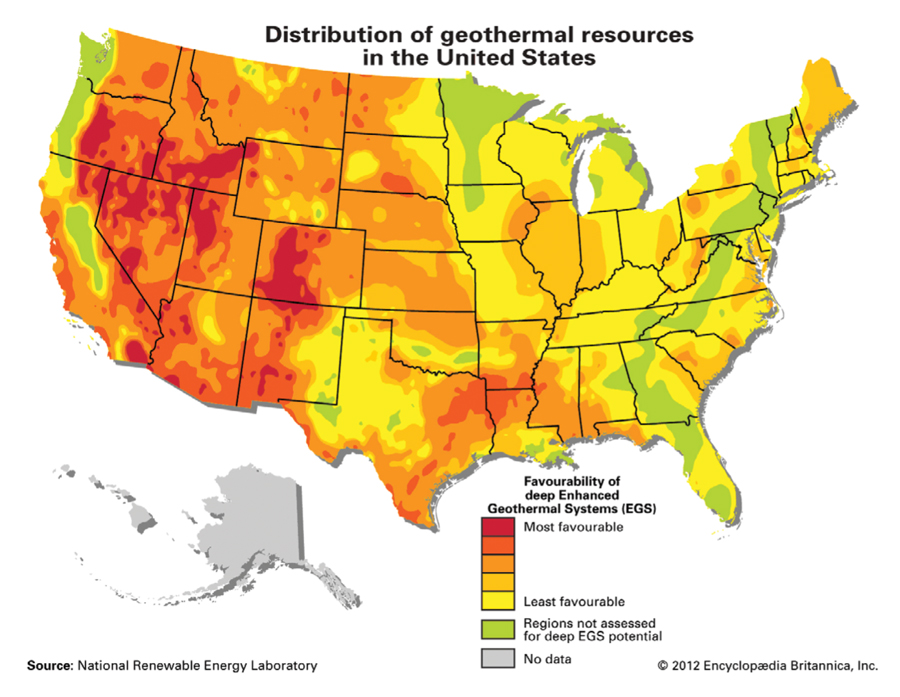
This map shows geothermal energy resources in the United States. As you can see, some areas have far more geothermal resources than others do.
The annual heat flow to the surface averages between 50 and 70 milliwatts (mW) per square meter worldwide. In contrast, incoming solar radiation striking Earths surface provides 342 watts per square meter annually. The estimated amount of geothermal energy that can be recovered and utilized on the surface is roughly three times the worlds annual consumption of all types of energy.
Geothermal energy is an alternative energy source. That means that it is one of several renewable power sources that can be used in place of fossil fuels and other traditional sources of energy, which are limited in supply and produce pollution and other environmental problems. Other alternative energy sources include solar power, wind power, and waterpower.
H eat from Earths interior is produced mainly by the radioactive decay of elements in Earths crust and mantle and also by friction generated along the margins of continental plates. It generates surface phenomena such as lava flows, geysers, fumaroles, hot springs, and mud pots.
INSIDE EARTH
Earth is made up of three layers: the core, mantle, and crust. Temperatures and pressures rise with increasing depth inside the planet. At roughly 50 miles (80 kilometers) below the surface, the rock of the mantle is at about 2,500 degrees Fahrenheit (1,370 degrees Celsius) and becomes partly molten. Below about 150 to 200 miles (250300 km), the mantle is under so much pressure that it becomes more rigid again.
Beneath the mantle, the material becomes much denser and liquefies. Scientists believe that this layer, called the outer core, consists of up to 90 percent molten iron and nickel, with some other elements such as sulfur mixed in. Finally, below about 3,200 miles (5,100 km) is the inner core. This hottest layer is estimated to be between 8,000F and 12,000F (about 4,400C6,600C).

Earths interior has three main layers: a relatively thin, rocky crust; a thick mantle; and a largely molten core. The measurements provided are averages.
Some of the heat in Earths interior is left over from the planets formation, and some is released from the outer core as iron and nickel slowly solidifies. Most of the heat, though, is believed to result from the decay of long-lived radioactive elements such as potassium, thorium, and uranium.
RADIOACTIVITY
Radioactivity is a feature of certain types of matter. All matter is made of chemical elements, and elements are made of atoms. Most atoms are stable. That is, they do not change over time. Radioactive atoms, however, change over time. Tiny subatomic particles and energy fly out of them naturally. The particles and energy that are released are a form of radiation.
The atoms are changed a little bit each time they release something. They keep giving off particles and energy until they are changed into a stable form. That process is called decay. The amount of time that each type of atom takes to decay varies greatly. It can be less than a second or millions of years. The measure of that rate is called a half-life. This refers to the time required for one half of a group of atoms to decay into a stable form.

